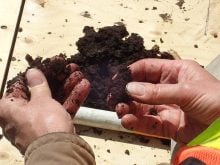Wireworms can dig deep into the soil to avoid frost and survive cold temperatures, according to research out of Prince Edward Island.
Christine Noronha, an entomologist with Agriculture Agri-Food Canada (AAFC) in Charlottetown, recently studied how deep, and at what times, wireworms were on the move in the soil.
There are no in-season chemical options against wireworms.
Varieties of wireworm are a common pest across Canada. In P.E.I., a particularly aggressive variety has caused massive damage in crops such as potatoes, carrots and other root crops, Noronha told the Co–operator.
Read Also

Manitoba boosts stake in cereals centre to $23.5 million
Premier Wab Kinew said the additional project funds will help ‘Trump-proof’ the provincial economy.
The larvae of this species can live in the soil for five years. After that, they spend their short adult lives as click beetles. Unfortunately, it’s the larvae that are the main problem.
That longevity in the soil is one reason wireworms have been so hard to control. Another is that since the pests are not in the open air, chemical controls are limited to seed treatments.
“Once you have a field with wireworms in it, those wireworms are there for five years,” Noronha said.
There also haven’t been a lot of good chemical options. Since the early ‘00s, tightened regulations have phased out a number of products that were once used against wireworms.
Between then and 2020, the industry was mostly relying on neonicotinoids. Those products, however, did not kill most wireworms in the field, according to provincial entomologist John Gavloski. They only made the larvae sick.
Neonics were also facing down their own regulatory scrutiny.
With the registration of broflanilide a little under two and a half years ago, the door was once again open to active control of wireworm populations.
Atlantic research
To get a better idea of larvae behaviour, Noronha and her team released wireworms into tubes that stretched 80 centimetres into the soil. They then pulled those tubes out at different times throughout the year to observe how far down the worms had gone and when it was happening.
The wireworms began to move deeper into the soil in October and continued to descend slowly throughout November. They then stay below the frost line, and may even go deeper, Noronha said.
In April, when the soil temperature at the test site reached eight to ten degrees, the worms will begin moving back up.
This tells P.E.I. farmers when they should be putting out baits, one method used to test for the presence of wireworms in a field before planting.
In P.E.I., the end of April to mid-May is the best time to put out traps, Noronha said. If farmers need to test in fall, late September is best.

Manitoba application
Manitoba has different species of wireworms, and they are less prevalent than in P.E.I. However, the province does see sporadic, localized damage from the pest, Gavloski said.
Manitoba winters are also colder than in P.E.I. — soil temperatures on the island rarely fall below –7 C, an AAFC report noted.
However, Noronha said Manitobans could still use the temperature thresholds unveiled by her research to predict wireworm movement.
Additional research showed that P.E.I. wireworms could survive an average temperature of –7 C to –12 C, though one worm survived up to –20 C, an article from AAFC said.
Noronha has also done extensive research into using buckwheat and brown mustard in rotations to combat wireworms.
She and other researchers found that mustard and buckwheat were toxic to the pests and growing them in rotation could suppress populations.
Her colleagues have since tried mustard in Ontario and buckwheat in Quebec. Both worked, meaning it is an effective strategy against at least three varieties of wireworm, Noronha said.
Asked if buckwheat and brown mustard would be effective against Manitoban wireworms, Noronha said it was likely.
“It needs to be tested,” she said.
















